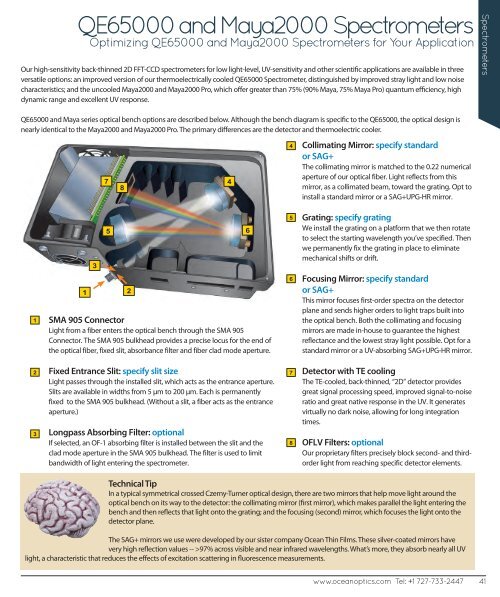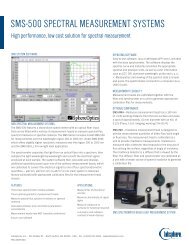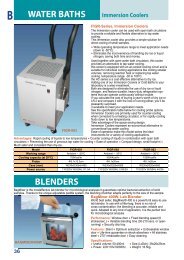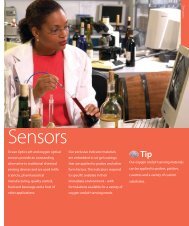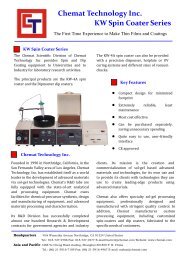S p e ctro m ete rs Ocean Optics pioneered the concept of ... - NDN
S p e ctro m ete rs Ocean Optics pioneered the concept of ... - NDN
S p e ctro m ete rs Ocean Optics pioneered the concept of ... - NDN
You also want an ePaper? Increase the reach of your titles
YUMPU automatically turns print PDFs into web optimized ePapers that Google loves.
QE65000 and Maya2000 Spe<strong>ctro</strong>m<strong>ete</strong><strong>rs</strong><br />
Optimizing QE65000 and Maya2000 Spe<strong>ctro</strong>m<strong>ete</strong><strong>rs</strong> for Your Application<br />
Our high-sensitivity back-thinned 2D FFT-CCD spe<strong>ctro</strong>m<strong>ete</strong><strong>rs</strong> for low light-level, UV-sensitivity and o<strong>the</strong>r scientific applications are available in three<br />
ve<strong>rs</strong>atile options: an improved ve<strong>rs</strong>ion <strong>of</strong> our <strong>the</strong>rmoelectrically cooled QE65000 Spe<strong>ctro</strong>m<strong>ete</strong>r, distinguished by improved stray light and low noise<br />
characteristics; and <strong>the</strong> uncooled Maya2000 and Maya2000 Pro, which <strong>of</strong>fer greater than 75% (90% Maya, 75% Maya Pro) quantum efficiency, high<br />
dynamic range and excellent UV response.<br />
QE65000 and Maya series optical bench options are described below. Although <strong>the</strong> bench diagram is specific to <strong>the</strong> QE65000, <strong>the</strong> optical design is<br />
nearly identical to <strong>the</strong> Maya2000 and Maya2000 Pro. The primary differences are <strong>the</strong> d<strong>ete</strong>ctor and <strong>the</strong>rmoelectric cooler.<br />
7<br />
8<br />
4<br />
4<br />
Collimating Mirror: specify standard<br />
or SAG+<br />
The collimating mirror is matched to <strong>the</strong> 0.22 numerical<br />
aperture <strong>of</strong> our optical fiber. Light reflects from this<br />
mirror, as a collimated beam, toward <strong>the</strong> grating. Opt to<br />
install a standard mirror or a SAG+UPG-HR mirror.<br />
Spe<strong>ctro</strong>m<strong>ete</strong><strong>rs</strong><br />
1<br />
1<br />
3<br />
5 6<br />
2<br />
SMA 905 Connector<br />
Light from a fiber ente<strong>rs</strong> <strong>the</strong> optical bench through <strong>the</strong> SMA 905<br />
Connector. The SMA 905 bulkhead provides a precise locus for <strong>the</strong> end <strong>of</strong><br />
<strong>the</strong> optical fiber, fixed slit, absorbance filter and fiber clad mode aperture.<br />
5<br />
6<br />
Grating: specify grating<br />
We install <strong>the</strong> grating on a platform that we <strong>the</strong>n rotate<br />
to select <strong>the</strong> starting wavelength you’ve specified. Then<br />
we permanently fix <strong>the</strong> grating in place to eliminate<br />
mechanical shifts or drift.<br />
Focusing Mirror: specify standard<br />
or SAG+<br />
This mirror focuses fi<strong>rs</strong>t-order spectra on <strong>the</strong> d<strong>ete</strong>ctor<br />
plane and sends higher orde<strong>rs</strong> to light traps built into<br />
<strong>the</strong> optical bench. Both <strong>the</strong> collimating and focusing<br />
mirro<strong>rs</strong> are made in-house to guarantee <strong>the</strong> highest<br />
reflectance and <strong>the</strong> lowest stray light possible. Opt for a<br />
standard mirror or a UV-absorbing SAG+UPG-HR mirror.<br />
2<br />
3<br />
Fixed Entrance Slit: specify slit size<br />
Light passes through <strong>the</strong> installed slit, which acts as <strong>the</strong> entrance aperture.<br />
Slits are available in widths from 5 µm to 200 µm. Each is permanently<br />
fixed to <strong>the</strong> SMA 905 bulkhead. (Without a slit, a fiber acts as <strong>the</strong> entrance<br />
aperture.)<br />
Longpass Absorbing Filter: optional<br />
If selected, an OF-1 absorbing filter is installed between <strong>the</strong> slit and <strong>the</strong><br />
clad mode aperture in <strong>the</strong> SMA 905 bulkhead. The filter is used to limit<br />
bandwidth <strong>of</strong> light entering <strong>the</strong> spe<strong>ctro</strong>m<strong>ete</strong>r.<br />
7<br />
8<br />
D<strong>ete</strong>ctor with TE cooling<br />
The TE-cooled, back-thinned, “2D” d<strong>ete</strong>ctor provides<br />
great signal processing speed, improved signal-to-noise<br />
ratio and great native response in <strong>the</strong> UV. It generates<br />
virtually no dark noise, allowing for long integration<br />
times.<br />
OFLV Filte<strong>rs</strong>: optional<br />
Our proprietary filte<strong>rs</strong> precisely block second- and thirdorder<br />
light from reaching specific d<strong>ete</strong>ctor elements.<br />
Technical Tip<br />
In a typical symmetrical crossed Czerny-Turner optical design, <strong>the</strong>re are two mirro<strong>rs</strong> that help move light around <strong>the</strong><br />
optical bench on its way to <strong>the</strong> d<strong>ete</strong>ctor: <strong>the</strong> collimating mirror (fi<strong>rs</strong>t mirror), which makes parallel <strong>the</strong> light entering <strong>the</strong><br />
bench and <strong>the</strong>n reflects that light onto <strong>the</strong> grating; and <strong>the</strong> focusing (second) mirror, which focuses <strong>the</strong> light onto <strong>the</strong><br />
d<strong>ete</strong>ctor plane.<br />
The SAG+ mirro<strong>rs</strong> we use were developed by our sister company <strong>Ocean</strong> Thin Films. These silver-coated mirro<strong>rs</strong> have<br />
very high reflection values -- >97% across visible and near infrared wavelengths. What’s more, <strong>the</strong>y absorb nearly all UV<br />
light, a characteristic that reduces <strong>the</strong> effects <strong>of</strong> excitation scattering in fluorescence measurements.<br />
www.oceanoptics.com Tel: +1 727-733-2447 41


